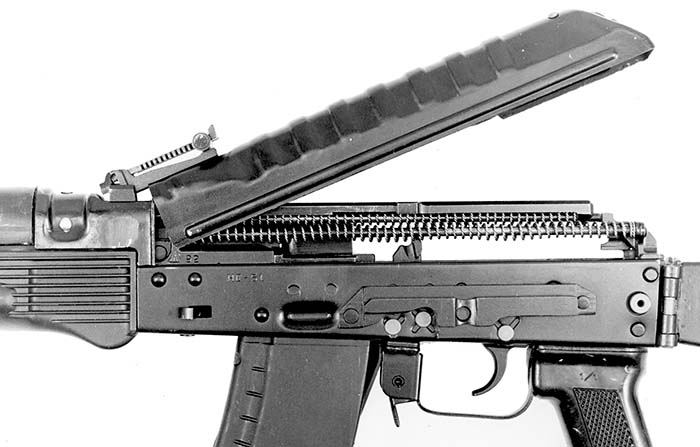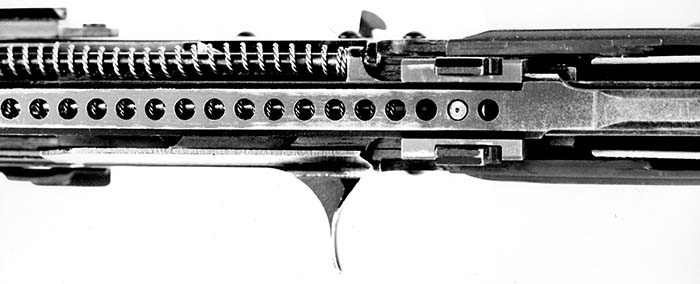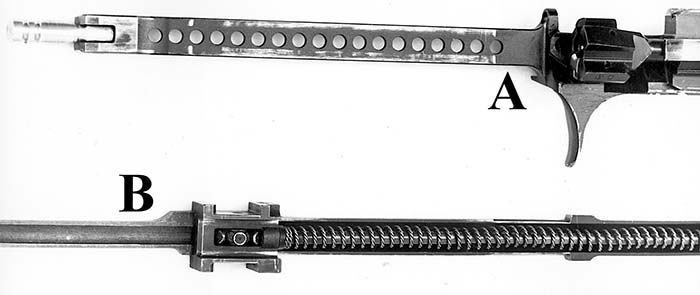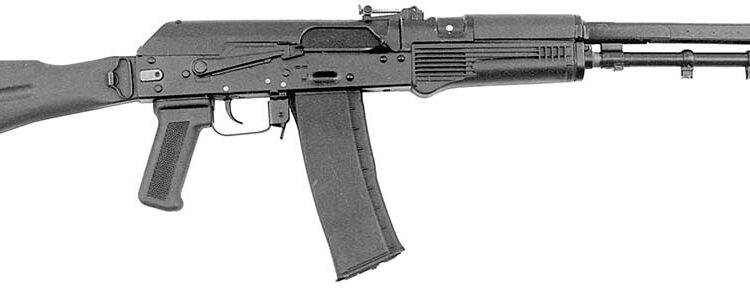By Charles Q. Cutshaw & Valery Shilin
The Avtomat Kalashnikova has been a centerpiece of the world’s military small arms since 1949, when it was fielded in the Soviet Army. In the years since its introduction, the basic AK has been updated and improved several times. The basic AK-47 was modified and refined through the 1950s until 1959 when it was redesignated AKM after a major “product improvement” redesign. In 1974 the AK-74, a further modified and improved version of Kalashnikov’s rifle, went into Soviet military service. The AK-74M continues in Russian military service to this day, along with similar rifles which make up the AK-100 series Kalashnikovs(AK-101 through AK-105) manufactured by Izmash in Izhevsk, Russia. At the time of the AK-100 series’ introduction several years ago, it appeared that the Kalashnikov rifle had reached the end of its modernization capacity, but recent developments at Izmash have proven that the AK not only still has life, but that it can be modernized and made competitive with most assault rifles of more recent design. The latest manifestations of the AK are the AK-107/AK-108 rifles. These rifles are chambered in 5.45x39mm and 5.56x45mm, respectively, and mark the most significant change of the basic AK design since the introduction of the AK-74.
What differentiates the new rifles from any of their predecessors is the introduction of a “balanced” gas counterrecoil operating system that essentially functions on the principle of Newton’s Third Law of Physics, which can be summarized as, “For every action, there is an equal and opposite reaction.” This new operating system also has mandated other changes in the basic AK design, as we shall presently see.

The AK-107/108 are essentially updated versions of the experimental AL-7 (AL: Avtomat Lehkiy – “Light assault rifle”) rifle of the early 1970’s. Most of the illustrations for this article are of the AL-7, as detailed photos of the AK-107 and AK-108 are currently not available in the US, but the functioning and internal configuration of the AL-7 and AK-107/108 is virtually identical. The AL-7 was the brainchild of Yuriy Alexandrov, at the time a promising young designer and protégé of Evgeniy Dragunov. In 1969 Alexandrov was assigned the task of designing a new rifle to take advantage of the then-new 5.45x39mm cartridge, using the AKM as a starting point. The rifle he designed and which unsuccessfully competed against the AK-74 in 1972 was very similar in external appearance to today’s AK-100 series rifles with the exception of a thick gas tube cover and ribbed receiver cover, but internally there were radical changes. With the exception of the plain receiver cover, today’s AK-107/108 is virtually identical in every respect to the 1972 experimental rifle. In fact, the original designer of the AL-7, Yuriy Alexandrov, now a senior engineer, headed the team that brought his original rifle up to date to produce the AK-107/108. It should be noted that the new designation does not denote Avtomat Kalashnikova as it has in all previous AKs. The AK designation of the new rifles stands for Alexandrov/ Kalashnikov, indicating the integration of the Alexandrov operating system into the Kalashnikov receiver.
The reason for the introduction of the 5.45x39mm cartridge was a desire on the part of the Soviet military for a reduction in recoil with a concomitant increase in both accuracy and lethality as evidenced by the US experience with cartridges of that class. The net effect of the AL-7 operating system was to almost totally eliminate felt recoil. Despite the virtual elimination of perceived recoil, the AL-7 probably was too radical a change and was too expensive to produce at the time it was designed in comparison to its competitor which eventually was fielded as the AK-74. Why the AL-7 was too expensive in the 1970’s but is considered reasonably priced for production today will be explained below.

There are a number of external differences between the AK-107/108 and their predecessors in the AK-100 series. First is the method of attaching the receiver cover to the receiver. The new operating system eliminates the traditional AK “button” at the end of the recoil spring guide that protrudes through the center rear of the receiver cover and is depressed to lift the cover and disassemble the rifle. The new AKs have the receiver cover retained by a integral latch at the rear and retention at the front is via the rear sight. This can clearly be seen in Figure 6, which shows the AL-7 receiver cover partially lifted. The rear sight is fixed to the receiver cover and mates with a lug at the rear of the gas tube cover. Another external difference is that what appears to be a larger square gas tube is actually a cover that houses the bolt carrier connecting rod, counterrecoil upper rail and associated springs. The shape of the ejection port has been modified to accommodate the altered bolt travel and ejection pattern of the AK-107/108. The selector lever now has four positions rather than three to allow selection of safe, semiautomatic, three round burst or full automatic functions, in contrast to the original AL-7, which had a standard three position AK selector and was capable only of semiautomatic or fully automatic fire.

As mentioned, the original AL-7 essentially eliminated felt recoil via a “balanced” counterrecoil system which has been incorporated into the new AKs. The operation of the balanced system is fairly straightforward, but the reader will probably understand it better by referring to the accompanying illustrations. Because the functioning of the rifle other than the counterrecoil system is typical Kalashnikov, we will not describe it in detail, concentrating instead on the operation of the counterrecoil system. The components of the system can be seen in Figure 3, which shows the AL-7 field stripped and Figure 4, which shows a “top down” view into the AL-7 receiver. The bolt carrier and “connecting rail” and lower connecting rod are shown in Figure 5. The concept of the Alexandrov counterrecoil system is simple – the operating forces are simultaneously transmitted both forward and to the rear, countering each other. As can be imagined, timing and synchronizing the counterbalancing forces is the key to the efficacy of the system. This is accomplished by the bolt carrier’s perforated connecting rail and the six toothed sprocket shown in Figure 5b. The sprocket can be seen in Figure 4 engaging the second perforation of the bolt carrier connecting rail. Note in Figure 3 that both the bolt carrier and lower connecting rod have gas pistons, but that they face in opposite directions. Note also that the short gas tube atop the barrel just forward of the forearm is open at both ends. When the rifle is fired, gas is tapped from the barrel gas port and enters the gas tube, driving the bolt carrier to the rear and the counterrecoil upper rail forward. As with most semiautomatic and automatic firearms, timing is everything with the AK-107/108 and this critical element is attained by a six-toothed sprocket mounted in the lower rail (Figure 5b). The sprocket links together and synchronizes the rifle’s reciprocating parts, causing both components to reach their maximum extension, or null points, where forces are exactly equal, simultaneously. The bolt carrier and lower rail thus counter each other, thereby virtually eliminating felt recoil and muzzle rise. As soon as the carrier and rail reach their null points their respective springs cause them to begin to reciprocate and the sprocket results in their return to battery simultaneously, again countering each other’s forces. The distance the reciprocating parts must travel in the AK-107/108 is shorter than the AK-74M and other members of the AK-100 family, so the AK-107/108’s 850-900 round per minute cyclic rate is appreciably higher than its immediate predecessors, which had a cyclic rate of only 600 rounds per minute.

As mentioned, the AK-107/108 are select fire with three round burst in addition to semiautomatic and full automatic fire. The three round burst feature is accomplished by a ratchet and pawl device. The pawl is part of the bolt carrier and the ratchet is part of the sear mechanism. In basic terms, the ratchet has three teeth and when the selector is placed in the “burst” position, the ratchet moves into position for interaction with the pawl on the bolt carrier, also disabling the disconnector. As the trigger is squeezed, the pawl on the bolt carrier moves the ratchet one tooth, preventing the sear from catching the hammer. As the third round is fired, the ratchet is released and returns to its original position, releasing the disconnector thus allowing the sear to engage the hammer and interrupt the operating cycle. When the trigger is released, the ratchet returns to its original position and is reset. When the trigger is again squeezed, the process repeats. This system provides a three round burst each time the trigger is squeezed and the selector is in the “burst” position.

This, then, summarizes the technical background to the new AKs, but given that the AK-100 series rifles are improved versions of the venerable Kalashnikov design, why resurrect and update a design that is nearly 30 years old? There are actually a number of cogent reasons for this. First, sales of the AK-100 series rifles have not been very great. This is not because they are bad rifles, but they actually offer little improvement over older AK versions and despite the introduction of AKs in 5.56mm NATO, former Warsaw Pact nations are either rebuilding their own small arms industries, in many cases beginning manufacture of their own rifles, or buying rifles from Western sources. Moreover, Kalashnikov rifles have flooded the world market. A functioning AKM, for example, can be purchased in parts of Africa for less than $50, while a new AK-101 costs approximately $230 f.o.b. Izhevsk. Again, although the AK-100 rifles are modernized, they are not significantly improved in accuracy, reliability or function over their predecessors. The new AN-94 is a dramatic improvement in every respect over AKs, but the new rifle is very complex and costly to produce – some five times more than an AK-101! It became apparent to the marketing managers at Izmash that simply making marginally improved AKs would not result in sales, and the AN-94 was too expensive to be competitive in the world small arms market. What might sell, they reasoned, was a version of the proven AK design, but one with real improvements such as better accuracy and increased effectiveness. The AK-107/108 rifles provide notable levels of improvement, while maintaining the legendary Kalashnikov reliability, simplicity at only a moderate cost increase. The AK-107 and AK-108 are claimed by the manufacturer to achieve 1.5 times the accuracy of their comparable AK-100 series rifles using identical ammunition. As we have noted, the new AK-108 and 108 rifles are really no more than AK-74Ms with the operating system of the AL-7, which itself was essentially an AKM in 5.45x39mm with a new operating system. Despite the improvements made, the question remains whether or not the new AKs will sell in a highly competitive world small arms market that is for all intents and purposes “flat” at the moment. Only time will tell whether or not the new rifles will result in sales for Izmash, but the 1990’s is generally not a good time for anyone to be in the military small arms manufacturing business.
| This article first appeared in Small Arms Review V2N6 (March 1999) |












